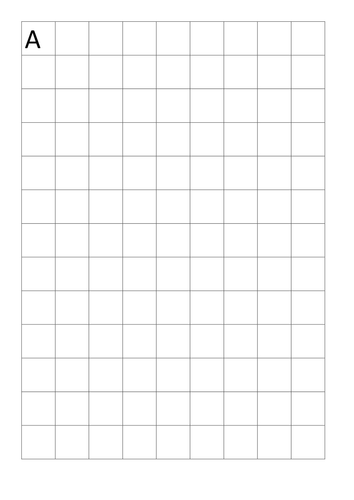







Fun exercise for many age ranges. Will provide a good amount of discussion and is a nice next step after estimating and experimental probabilities.
Originally I used this as one short activity in a "Circus" of many activities which students go around the room playing on. (More of my Circus Activities are uploaded on my TES resources elsewhere).
There are several versions of the task here which you can adapt for your learners. The basic idea is that you give a sheet of card with a grid printed onto it. Players roll coins on to the card and if the coins land so that the side sides of the coin are not touching the sides they win. One idea is you give them a variety of size grids (e.g. grid A and grid B) where the coins do or don't fit in easily.
I prepare a set of game boards (A & B) for each pair of students and give them a money bag with 7 plastic toy coins in (1p, 2p, 5p, 10p, 20p, 50p, £1). You could use real money or even £2 coins if you have them.
2p is a large coin but isn't worth much so its makes it hard to win, but if you only win your stake back then you don't win much.
£2 is a large coin and is worth lots so its makes it hard to win, but if you only win your stake back then you win loads.
If you are doing this as a 10 minute circus activity then keep it simple. If you are doing it as a more extended piece of work then use the updated task sheet which asks the students to work out how to make the most money. Higher students will need encouragement to keep the game rules simple. Lower students will need encouragement to keep it really simple. You may choose to give them a reduced version of the problem.
You can see that I then for the next lesson typed their suggestions into a worksheet which they then started the next lesson by answering the worksheet. I think there is a lot of potential here to really develop the idea of how to test the games... e.g. they need to try 100 goes with each size coin, etc.
The activity certainly gets them discussing whether games are 'attractive' to play and so will bring in more money. The students usually feel that a high prize will make people want to play - even if the game is difficult to win. You could easily extend this activity into GCSE level maths to work out the profits possible.
Originally I used this as one short activity in a "Circus" of many activities which students go around the room playing on. (More of my Circus Activities are uploaded on my TES resources elsewhere).
There are several versions of the task here which you can adapt for your learners. The basic idea is that you give a sheet of card with a grid printed onto it. Players roll coins on to the card and if the coins land so that the side sides of the coin are not touching the sides they win. One idea is you give them a variety of size grids (e.g. grid A and grid B) where the coins do or don't fit in easily.
I prepare a set of game boards (A & B) for each pair of students and give them a money bag with 7 plastic toy coins in (1p, 2p, 5p, 10p, 20p, 50p, £1). You could use real money or even £2 coins if you have them.
2p is a large coin but isn't worth much so its makes it hard to win, but if you only win your stake back then you don't win much.
£2 is a large coin and is worth lots so its makes it hard to win, but if you only win your stake back then you win loads.
If you are doing this as a 10 minute circus activity then keep it simple. If you are doing it as a more extended piece of work then use the updated task sheet which asks the students to work out how to make the most money. Higher students will need encouragement to keep the game rules simple. Lower students will need encouragement to keep it really simple. You may choose to give them a reduced version of the problem.
You can see that I then for the next lesson typed their suggestions into a worksheet which they then started the next lesson by answering the worksheet. I think there is a lot of potential here to really develop the idea of how to test the games... e.g. they need to try 100 goes with each size coin, etc.
The activity certainly gets them discussing whether games are 'attractive' to play and so will bring in more money. The students usually feel that a high prize will make people want to play - even if the game is difficult to win. You could easily extend this activity into GCSE level maths to work out the profits possible.
Get this resource as part of a bundle and save up to 63%
A bundle is a package of resources grouped together to teach a particular topic, or a series of lessons, in one place.
Something went wrong, please try again later.
This resource hasn't been reviewed yet
To ensure quality for our reviews, only customers who have purchased this resource can review it
Report this resourceto let us know if it violates our terms and conditions.
Our customer service team will review your report and will be in touch.
£3.00
